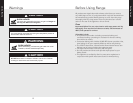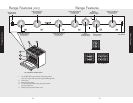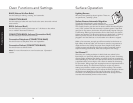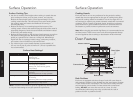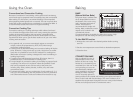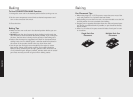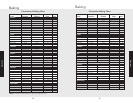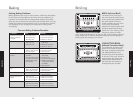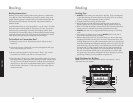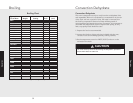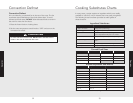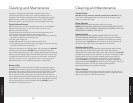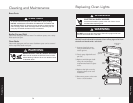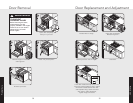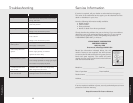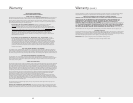
35
Control Panel
DO NOT use any cleaners containing ammonia or abrasives. They
could remove the graphics from the control panel. Use hot, soapy
water and a soft clean cloth.
Oven Surfaces
Several different finishes have been used in your oven.
NEVER USE AMMONIA, STEEL WOOL PADS OR ABRASIVE CLOTHS,
CLEANSERS, OVEN CLEANERS, OR ABRASIVE POWDERS. THEY CAN
PERMANENTLY DAMAGE YOUR OVEN.
Control Knobs
MAKE SURE ALL THE CONTROL KNOBS POINT TO THE OFF
POSITION BEFORE REMOVING. Pull the knobs straight off. Wash in
detergent and warm water. Dry completely and replace by pushing
firmly onto stem. DO NOT use any cleaners containing ammonia or
abrasives. They could remove the graphics from the knob.
Stainless Steel Parts
All stainless steel body parts should be wiped regularly with hot soapy
water at the end of each cooling period and with a liquid cleaner
designed for that material when soapy water will not do the job. DO NOT
use steel wool, abrasive cloths, cleansers, or powders. If necessary, scrape
stainless steel to remove encrusted materials, soak the area with hot
towels to loosen the material, then use a wooden or nylon spatula or
scraper. DO NOT use a metal knife, spatula, or any other metal tool to
scrape stainless steel. DO NOT permit citrus or tomato juice to remain on
stainless steel surface, as citric acid will permanently discolor
stainless steel. Wipe up any spills immediately.
Glass Surfaces
Clean with detergent and warm water. Glass cleaner can be used to
remove fingerprints. If using glass cleaner ammonia, make sure that it
does not run down on exterior door surface.
34
Product Care
Any piece of equipment works better and lasts longer when
maintained properly and kept clean. Cooking equipment is no
exception. Your range must be kept clean and maintained properly.
Before cleaning, make sure all controls are in the “OFF” position.
Disconnect power if you are going to clean thoroughly with water.
Open Surface Burners
Wipe up spill-overs as soon as possible after they occur and before
they get a chance to burn in and cook solid. In the event of a
spill-over, follow these steps:
• Allow the burner and grate to cool to a safe temperature level.
• Lift off the burner grate. Wash in warm soapy water.
• If the spill is contained in the bowl of the grate support, just remove
the bowl and clean in warm soapy water.
• Lift the grate support off.
• Wash these parts in hot, soapy water and rinse clean.
• If the spill has gone lower than the grate supports, draw out the drip
pan and wash with hot, soapy water.
If ports on the burners are clogged, clean with a straight pin. DO NOT
enlarge or distort the ports. DO NOT use a toothpick to clean the
ports. When replacing burner caps, carefully align the tabs underneath
the cap with the outside edge of burner. Make sure burner cap is level.
Occasionally check the burner for proper size and shape. If flames lift
off ports, are yellow, or are noisy when turned on, you may need to
clean the burners or call a qualified technician for adjustment.
Burner Caps
The surface burner caps should be routinely removed and cleaned.
ALWAYS clean the burner caps after a spill-over. Keeping the burner
caps clean will prevent improper ignition and uneven flames. To clean,
pull burner cap straight up from the burner base. Wipe off surface
burner caps with warm, soapy water and a soft cloth after each use.
Use a non-abrasive cleanser such as Bon Ami™ and a soft brush or soft
Scotch Brite™ pad for cooked-on foods. Dry thoroughly after cleaning.
For best cleaning and to avoid possible rusting, DO NOT clean in
dishwasher or self-cleaning oven.
Cleaning and Maintenance
Cleaning and Maintenance
Product Care



